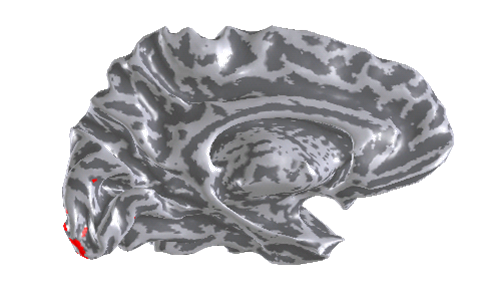Overview
Macular degeneration is the leading cause of blindness in the developed world. This retinal disease renders sufferers blind in the centre of the visual field. As a result, patients can no longer achieve high spatial resolution, which is only found in central visual field locations, and therefore struggle to read and perform other everyday visual tasks. The centre of the visual field has a disproportionately large representation in the human brain – about half the area of the primary visual cortical map is concerned with processing only the central 10 degrees of the visual field. Therefore, a large part of the visual brain receives no retinal input as a result of macular degeneration.
We have shown previously that the primary visual cortical map (V1) does not remap the visual information that remains spared in patients with macular degeneration. This is reassuring as a large reconfiguration on the visual cortex could limit the success of treatments that aim to restore retinal function in patients with macular degeneration. However, the success of restorative treatments also depends on the way in which different visual maps in the occipital lobe communicate with each other.
In this project the researchers investigated whether the second cortical visual area (V2) continued to sample information from V1 normally in the parts of these visual maps that no longer receive an input from the retina. This work relied on a newly established method - connective field modelling - that can assess the connectivity of brain areas even when those areas are not directly stimulated. It was found that connectivity between the two areas, V1 and V2, was largely maintained despite prolonged loss of visual input. These results suggest that the success of operations to restore sight in cases of macular degeneration would not be compromised by significant changes in the cortical visual fields maps. These findings will be presented at the European Conference on Visual Perception (ECVP) and a manuscript has been drafted and will be submitted before the end of 2013.
In detail
Macular degeneration is the leading cause of blindness in the developed world. This retinal disease renders sufferers blind in the centre of the visual field. As a result, patients can no longer achieve high spatial resolution, which is only found in central visual field locations, and therefore struggle to read and perform other everyday visual tasks. The project drew on local expertise in analysing Functional Magnetic Resonance Imaging (fMRI), to apply it specifically to the human visual system. In particular it investigated how the spatial pattern of brain connections in the visual cortex changes during development as well as in subjects rendered blind by disease of the eye. The aim was to answer these important scientific questions for the benefit of sufferers at the same time as creating a new, freely-available scientific tool that will empower the larger community of neuro-imagers at York to perform cutting edge research in the future.
The centre of the visual field has a disproportionately large representation in the human brain – about half the area of the primary visual cortical map is concerned with processing only the central 10 degrees of the visual field. Therefore, a large part of the visual brain receives no retinal input as a result of macular degeneration. The group published evidence previously that the primary cortical visual map (V1) does not remap the visual information that remains spared in patients with macular degeneration. This is important as a large reconfiguration on the visual cortex could limit the success of treatments that aim to restore retinal function in patients with macular degeneration. The success of restorative treatments however also depends on the manner in which different visual maps in the occipital lobe communicate with each other.
In the C2D2 funded work we investigated whether the second cortical visual area, V2, continues to sample information from V1 normally in the parts of these visual maps that no longer receive an input from the retina. This work relies on a newly established method - connective field modelling - that canassess the connectivity of brain areas even when those areas are not directly stimulated. We found that connectivity between areas V1 and V2 is largely maintained in patients with macular degeneration, although less strictly than in controls with simulated retinal lesions. However, the extent to which connectivity was disordered in the patients correlated negatively with their ability to keep their eyes stable while fixating. This suggests that the difference between the pattern of connectivity in patients and controls is related to poor fixation and that the spatial patterns of connectivity between visual maps remains largely intact, despite the prolonged loss of visual input. These results suggest that the restoration of sight in MD can probably assume largely unchanged cortical visual fields maps. These findings will be presented at the European Conference on Visual Perception (ECVP) and a manuscript has been drafted and will be submitted before the end of 2013.

